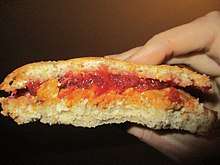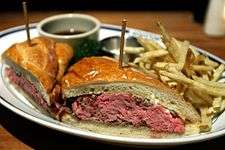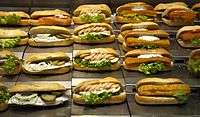Peanut butter and jelly sandwich
 A peanut butter and jelly sandwich on white bread | |
| Alternative names | PB&J |
|---|---|
| Course | Lunch or snack |
| Place of origin | United States |
| Serving temperature | Room temperature |
| Variations | Peanut butter and jam, other nut butters, with butter or marshmallow fluff |
| 403 kcal (1687 kJ) | |
A peanut butter and jelly (or jam) sandwich, or PB&J, includes one or more layers of peanut butter and one or more layers of either jelly (called Jam in British English) on bread. Sometimes the sandwich is eaten open-faced or with one slice of bread folded over (effectively a "half sandwich"). The sandwich is quite common and popular in North America, especially for children; a 2002 survey showed the average American will have eaten 1,500 of these sandwiches before high school graduation.[1]
There are several variations on the sandwich. For example, honey or sliced fruit can be substituted for the jelly component. On the flip side, the popularity of almond butter has inspired some aficionados to transition to "almond butter and jelly" (AB&J) sandwiches. Other nut butters are less common. Marshmallow fluff can also be substituted for the jelly, or simply added for extra flavor; this sandwich is called a "fluffernutter". Cream cheese, substituted for the peanut butter, makes a cream cheese and jelly sandwich. Nutella is another possible substitute for one of the spreads.
White bread is most commonly used, but whole wheat bread can be used as an option. Creamy peanut butter with jelly yields a very smooth sandwich, while chunky peanut butter and jam offers up a lot of texture. The sandwich may be served whole or cut. If the sandwich is left to sit, or prepared in the morning for lunchtime, then the jelly or jam may soak into the bread and create a soggy slice. The solution invented by sandwich-makers is to utilize the "barrier strategy", whereby a layer of peanut butter on each slice protects the bread from becoming soggy (see photo for "sandwich preparation").
History

Peanut butter was originally paired with a diverse set of foods, such as pimento, cheese, celery, watercress, and toasted crackers.[2] In a Good Housekeeping article published in May 1896, a recipe "urged homemakers to use a meat grinder to make peanut butter and spread the result on bread." The following month, the culinary magazine Table Talk published a "peanut butter sandwich recipe.[3][4] In the early 1900s, this sandwich was adopted down the class structure as the price of peanut butter dropped. It became popular with children by the 1920s as manufacturers began adding sugar to the peanut butter.[5] Since World War II, both peanut butter and jelly were found on US soldiers' military ration list.[6]
Nutrition
A peanut butter and jelly sandwich made with white bread, two tablespoons each of peanut butter and strawberry jelly, provides 403 kcal, 18 g fat, 58 g carbs and 12 g protein which is 27% of the Recommended Daily Intake of fat and 22% of calories.[7]
While roughly 50% of the calories are from fat, most of them come from monounsaturated fat and polyunsaturated fats, which have been linked positively with heart health.[8]
.jpg) Sandwich preparation
Sandwich preparation.jpg) Close-up view of a cut peanut butter and jelly sandwich
Close-up view of a cut peanut butter and jelly sandwich
See also
References
- ↑ "PB&J is A-OK". Prepared Foods 171.10. Prepared Foods. October 2002. p. 32. Retrieved August 28, 2017.
- ↑ Peanuts: The Illustrious History of the Goober Pea. University of Illinois Press. p. 35.
- ↑ Mark McWilliams. The Story Behind the Dish: Classic American Foods. ABC-CLIO. p. 166.
- ↑ Lau, Maya (June 7, 2013). "Who Made That?". New York Times Magazine.
- ↑ "Food Timeline". Lynne Olver.
- ↑ Why Do Donuts Have Holes?. Citadel Press. p. 127.
- ↑ Jegtvig, about.com, undated, "How Nutritious is a PB&J?", archived from the original, January 13, 2006. Accessed December 20, 2017.
- ↑ Corleone, Jill. "Are Peanut Butter & Jelly Sandwiches Healthy?". Retrieved 31 March 2012.
External links
| Wikimedia Commons has media related to Peanut butter and jelly sandwiches. |
| Wikibooks Cookbook has a recipe/module on |

